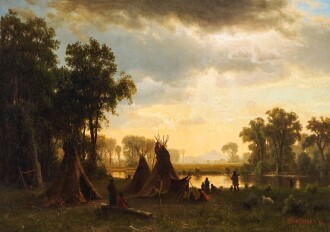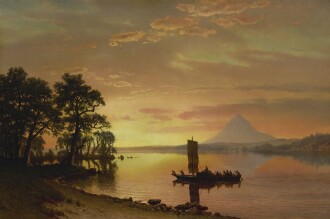Works by Albert Bierstadt at Sotheby's
Albert Bierstadt Biography
Among the most dramatic works of America’s first century, Albert Bierstadt’s vast, sweeping canvases captured the rugged sublimity of the Western landscape, and memorialized the heady era of manifest destiny.
Bierstadt was born on January 7, 1830, in Solingen, Germany, and immigrated to New Bedford, Massachusetts, with his family just one year later. He began to paint in oils in the early 1850s, and returned to Europe to hone his technical skills on Alpine peaks. In 1858 his large-scale painting of Lake Lucerne was exhibited in New York to critical acclaim, and the following spring he joined his first of several overland surveying expeditions to the American West. Laden with sketches and photographs of the Rocky Mountains, he returned to New York that autumn to establish himself in the Tenth Street Studio Building and begin to execute the paintings that would typify his career and embody the Romantic vision of the Hudson River School. Bierstadt’s expansive, exuberant vistas were nearly matched by his own self-promoting charisma, and his exhibitions were heavily advertised, ticketed affairs. In his later years, critics began to disparage his brand of aesthetic grandiosity, and by the time Bierstadt died on February 18, 1902, he has been largely forgotten. However, a series of exhibitions in the 1960s reignited interest in his work, and today his oeuvre is widely admired by scholars and collectors alike.
Bierstadt’s work can be found in numerous major American institutions such as the National Gallery of Art, Washington, DC, the Brooklyn Museum, New York, and the White House.
Read Less














